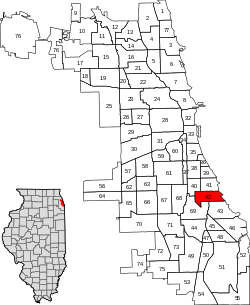Woodlawn, Chicago
| Woodlawn | |
|---|---|
| Community area | |
| Community Area 42 - Woodlawn | |
 |
|
 Location within the city of Chicago |
|
| Coordinates: 41°46.8′N 87°36′W / 41.7800°N 87.600°WCoordinates: 41°46.8′N 87°36′W / 41.7800°N 87.600°W | |
| Country | United States |
| State | Illinois |
| County | Cook |
| City | Chicago |
| Neighborhoods |
List
|
| Area | |
| • Total | 2.07 sq mi (5.36 km2) |
| Population (2015) | |
| • Total | 26,446 |
| • Density | 13,000/sq mi (4,900/km2) |
| Demographics 2014 | |
| • White | 7.79% |
| • Black | 85.23% |
| • Hispanic | 2.42% |
| • Asian | 2.79% |
| • Other | 1.77% |
| Time zone | CST (UTC-6) |
| • Summer (DST) | CDT (UTC-5) |
| ZIP Codes | parts of 60637 |
| Median household income | $27,413 |
| Source: U.S. Census, Record Information Services | |
Woodlawn, on the South Side of Chicago, Illinois, is one of Chicago's 77 community areas. It is bounded by Lake Michigan to the east, 60th Street to the north, Martin Luther King Drive to the west, and 67th Street to the south. Both Hyde Park Career Academy and the all-boys Catholic Mount Carmel High School are in this neighborhood; much of its eastern portion is occupied by Jackson Park. The Woodlawn section of the park includes the site of the planned Obama Presidential Library. The northern edge of Woodlawn contains a portion of the campus of the University of Chicago.
In the 1990 census, Woodlawn had approximately 27,000 individuals, living in 10,000 households. Over 98% of the population was African American, over half were on some form of public aid, and the median household income was over $13,000. As of 2008, according to city-data.com, the median household income is over $25,000 and in parts of eastern Woodlawn the white population is almost 30% and growing fueled by gentrification.
Up until 1948, Woodlawn was a middle class, white neighborhood, which grew out of the floods of workers and commerce from the 1893 World's Columbian Exposition. During the first half of the century, many University of Chicago professors lived in Woodlawn. With the Supreme Court ruling outlawing racially restrictive covenants in the 1950s, the combination of the expanding African American urban population, their limited housing options, and exploitive real estate maneuvers that divided up apartments into kitchenettes, Woodlawn began to have its first African American residents. Cayton and Drake described the anxieties and clashes that took place at the edge of the ghetto in Black Metropolis. The play Raisin in the Sun is based on Lorraine Hansberry and her family, who were one of the first to move in.
...
Wikipedia
